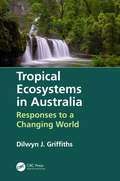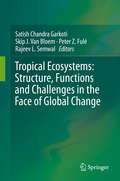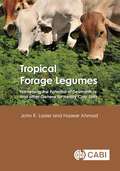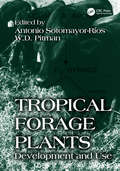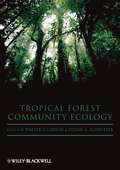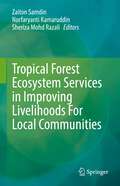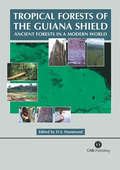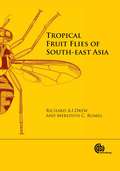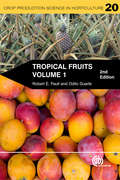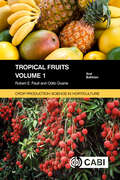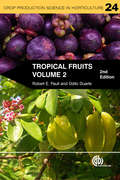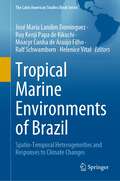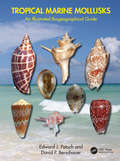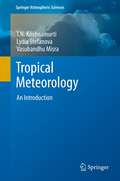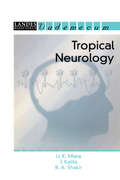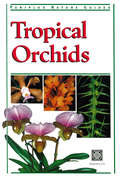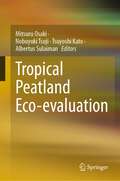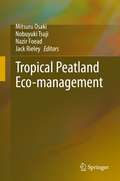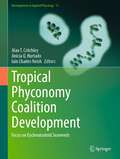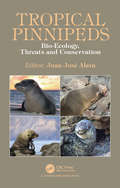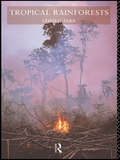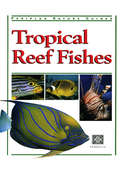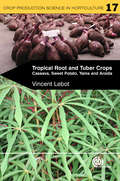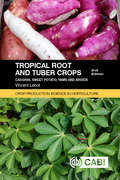- Table View
- List View
Tropical Ecosystems in Australia: Responses to a Changing World
by Dilwyn GriffithsOver the last century, the world has lived through changes more rapid than those experienced at any other time in human history, leading to pressing environmental problems and demands on the world’s finite resources. Nowhere is this more evident than across the world’s warm belt; a region likely to have the greatest problems and which is home to some of the world’s most disadvantaged people. This book reviews aspects of the biology of tropical ecosystems of northern Australia, as they have been affected by climatic, social and land-use changes. Tropical Australia can be regarded as a microcosm of the world’s tropics and as such, shares with other tropical regions many of the conflicts between various forms of development and environmental considerations. The book draws on a wide range of case studies of tropical Australian ecosystems ranging from coastal coral reefs and mangroves, known to be among the most vulnerable to the effects of the imposed changes, to cropping and pasture lands which, under careful management, have the potential remain as productive and sustainable agricultural or forestry ecosystems. Expert author Dilwyn Griffiths -emphasizes the importance of maintaining an active program for the establishment and management of national parks and environmental reserves -describes the effects of mining and other forms of industrial and urban development with particular reference to mine-site rehabilitation - explores problems relating to the restoration of marginally uneconomic farming land as alternative forms of land-use such as carbon farming through photosynthetically-driven carbon sequestration. This accessible reference work should find a place in educational libraries at all levels and become an essential resource for environmentalists and anyone with interests in various forms of land-use and development.
Tropical Ecosystems: Structure, Functions and Challenges in the Face of Global Change
by Satish Chandra Garkoti Skip J. Van Bloem Peter Z. Fulé Rajeev L. SemwalThe book brings together research topics having a broad focus on human and climate change impacts on the terrestrial ecosystems in the tropics in general and more specifically from the most significant and vulnerable Himalayan ecosystem. A total of 16 contributions included in the book cover a diverse range of global change themes such as the impacts of changing temperature and precipitation on soil ecosystems, forest degradation, extent and impacts of invasive species, plant responses to pollution, climate change impacts on biodiversity and tree phenology, environmental changes associated with land use, importance of traditional knowledge in climate change adaptation, timberline ecosystems, and role of integrated landscape modeling for sustainable management of natural resources. The book is a collective endeavour of an international multidisciplinary group of scientists focused on improving our understanding of the impacts of global change on the structure and functioning of tropical ecosystems and addressing the challenges of their future sustainable management. We hope that the book will help researchers working in the areas of ecology and environmental science to update their knowledge. We also expect that natural resource managers and policy planners will find explanations for some of their observations and hypotheses on multiple global change factors impacting tropical ecosystems and especially Himalayan ecosystems.
Tropical Forage Legumes
by Edited byJohn R. Lazier Nazeer AhmadThe development of legume use in agricultural production in the tropics lags far behind the temperate areas and extensive research over recent decades has aimed to rectify the lack of available leguminous fodder species available for heavy clay soils. This book draws together that research and explores the importance of heavy clay soils to agricultural productivity in the tropics and subtropics and the identification of adapted, productive forage legumes for these environments. Covering over four decades of international research, Tropical Forage Legumes: · Includes a detailed analysis of the forage germplasm available which is adapted to heavy clay soils · Covers the adaptation of a wide range of forages on Australian clay soils, and the evaluation of successful native and exotic forage legume species that have potential for those in Belize · Explores the genetics of the most promising genera, Desmanthus and Stylosanthes, and looks at the results from countries where new genotypes have been found to be productive and persistent · Provides details of a number of exciting new species, especially those in Desmanthus which have the potential to be, or have been commercialized · Makes recommendations for future research Providing an invaluable example of how a global search for adapted and productive forage germplasm has been - and can be - undertaken, and allowing access to a significant body of knowledge that was acquired before the digitalization of reports, this book will be a key resource for new scientists and experienced researchers in the areas of agriculture and forage agronomy.
Tropical Forage Plants: Development and Use
by W. D. Pitman Antonio Sotomayor-RiosTropical Forage Plants: Development and Use covers the research and resulting pasture development in the tropics and subtropics, which has undergone dramatic changes in the past few decades. Providing a broad, global perspective, it serves as a comprehensive resource covering a wide range of subjects pertaining to forage and animal production in th
Tropical Forest Community Ecology
by Walter P. Carson Stefan A. SchnitzerHistorically, tropical ecology has been a science often content with descriptive and demographic approaches, which is understandable given the difficulty of studying these ecosystems and the need for basic demographic information. Nonetheless, over the last several years, tropical ecologists have begun to test more sophisticated ecological theory and are now beginning to address a broad array of questions that are of particular importance to tropical systems, and ecology in general. Why are there are so many species in tropical forests and what mechanisms are responsible for the maintenance of that vast species diversity? What factors control species coexistence? Are there common patterns of species abundance and distribution across broad geographic scales? What is the role of trophic interactions in these complex ecosystems? How can these fragile ecosystems be conserved? Containing contributions from some of the world’s leading tropical ecologists, Tropical Forest Community Ecology provides a summary of the key issues in the discipline of tropical ecology: Includes contributions from some of the world’s leading tropical ecologists Covers patterns of species distribution, the maintenance of species diversity, the community ecology of tropical animals, forest regeneration and conservation of tropical ecosystems
Tropical Forest Ecosystem Services in Improving Livelihoods For Local Communities
by Norfaryanti Kamaruddin Zaiton Samdin Sheriza Mohd RazaliThis edited book covers major importance of tropical forest diversity and its values to vegetation, wildlife, and the local community. It addresses the current issues and opportunities in the Southeast Asia’s tropical forests. This book lays the groundwork for a better understanding of tropical forest ecosystem services. Ecosystem services has four concepts: provisioning, regulating, cultural and supporting services. In an era of rapid population growth and increasing pressure on tropical natural resources, ecosystem services have become central to the discussion of climate change mitigation. The values of tropical forest ecosystem services deserve to be the highlighted when it comes to shaping responsible behaviors towards sustainable development goals (SDGs). This book is of interest and useful to researchers and academics teaching in the field of tropical forest conservation, tropical ecosystems, tropical products technology, ecotourism, forest plantation management, bio industrial economy, agroforestry business and marketing. Professionals, foresters, industrial entrepreneurs, ecologists, and a valuable source of reference to the relevant researchers and students in the region.
Tropical Forests of the Guiana Shield: Ancient Forests in a Modern World
by D. S. HammondThe Guiana Shield is an ancient geological formation located in the northern part of South America, covering an area of 1 million square kilometers. Despite its hostile environment, it is home to many unusual and highly specialized plants and animals, which constitute a rich area of biodiversity. Chapters in this book include hydrology, nutrient cycling, forest phenology, insect-plant interactions, forest microclimate, plant distributions, forest dynamics and conservation and management of flora and fauna. It provides a comprehensive and detailed review of the ecology, biology and natural history of the forests of the area.
Tropical Fruit Flies of South-East Asia
by Richard Drew Meredith C RomigAs global warming and species migration become more prevalent issues, there is an urgent need for a text that provides comprehensive taxonomic details and geographic distributions of Dacinae fruit flies within south-east Asia. In particular, some of the major pest species of this region are being introduced on a regular basis to new geographical areas, causing widespread food security issues and economic hardship. Quarantine and horticultural organisations require detailed information on these fruit fly species in order to detect and eradicate any new incursions. This major new reference work details the taxonomic research into the subfamily Dacinae, which contains the tropical fruit flies of south-east Asia, as well as many other regions of the world. While focusing on south-east Asian fauna, all known species are included, through a study of the type material available in museums around the world. Specimens collected in major surveys conducted across Asia from 1983 to present have also been used to ensure a complete, in-depth review of this subfamily. Providing complete descriptions and artwork of all species of Dacinae recorded from the south-east Asian region for the first time, this book is written and illustrated by experts with over 80 years' combined research experience. Areas covered include: India, Bhutan, Nepal, Sri Lanka, Myanmar, China, Taiwan, Japan, the Philippines, Palau, Vietnam, Thailand, Singapore, Malaysia and Indonesia. It is an essential reference for departments of agriculture, researchers and students of entomology and quarantine, horticultural and chemical industry personnel worldwide. Key features: - 120 recently discovered species - 500 detailed drawings - Revision of all known species - Updated geographical distributions and host records - Accurate list and detailed information of all known pest species This book will be followed by Keys to Fruit Flies of South-East Asia.
Tropical Fruits, Volume 1
by Dr Robert E Paull Dr Odilo DuarteThe first of two volumes, this book covers major tropical fruits such as avocado, litchi, mango, papaya and pineapple. Early chapters describe the tropics and its soils and deal with key issues such as tree management and postharvest handling, updated and expanded to include best handling practices and food safety issues and the way to address these issues in marketing. Following these are self-contained chapters on single fruits which provide in-depth studies of botany, areas of origin and distribution, descriptions of ecological requirements and world production and utilization of each fruit. Propagation & cultural practices from ancient to modern are described to show the regional differences that environmental and biological pressures exert on fruit production and fruit quality. Tropical Fruits is essential reading for students and teachers of horticulture as well as horticultural industry personnel and policy-makers.
Tropical Fruits, Volume 1 (Crop Production Science in Horticulture)
by Robert E Paull Odilo DuarteOver the past few years there has been an increase in the variety of tropical fruits available for consumption, due to improved breeding, postharvest management and distribution systems. The production and world trade of fresh tropical fruits is expected to expand further, aided by consumer demand for healthy diets and for trying new foods. The third edition of this book covers major tropical fruits such as avocado, banana, litchi, mango, papaya, and pineapple. The first five chapters describe general aspects of the tropical climate and its soils, fruit production techniques, tree management, and postharvest handling. Following these are self-contained chapters on single fruits that provide in-depth studies of botany, taxonomy, varieties, propagation, orchard management, biotic and abiotic problems, and utilization. The ancient and modern propagation and cultural practices are described to show the regional differences that environmental and biological pressures exert on fruit production and fruit quality. Tropical Fruits 3rd edition is essential reading for students and teachers of horticulture and tropical agriculture, as well as for horticultural industry personnel.
Tropical Fruits, Volume 2
by Robert E Paull Odilo DuarteVolume 2 of this revised edition of Tropical Fruits examines the more specialist tropical fruits such as guava, durian, mangosteen, passion fruits and palm fruits. With growing interest in the cultivation, production, study, sales and marketability of these specialist fruits, this is a timely and informative book. Topics like botany, soil and climate requirements, cultivar development, world production and harvesting and postharvest handling are covered in-depth for each crop. This practical and accessible book is an ideal text for Horticulture academics, researchers, extension workers, students, breeders, growers and policy makers.
Tropical Marine Environments of Brazil: Spatio-Temporal Heterogeneities and Responses to Climate Changes (The Latin American Studies Book Series)
by José Maria Landim Dominguez Ruy Kenji Papa de Kikuchi Moacyr Cunha de Araújo Filho Ralf Schwamborn Helenice VitalThis book provides an overview of the tropical marine environments of Brazil and a multi-disciplinary assessment of the impact of ongoing climate change in these environments. These changes will affect physical, biological and biogeochemical characteristics of coastal zones and oceans, modifying their ecological structure, their functions and the various services provided to humans and have the potential of causing severe socioeconomic impacts in local (coastal zone), regional (continental shelf and shallow seas) and global (ocean) scales. The Tropical Brazil presents a unique opportunity to evaluate how spatial and temporal heterogeneity influences the response and resilience of marine environments to climate changes. This region comprises the main reef constructions of the Western South Atlantic Ocean, the majority of the Brazilian deltas, one of the longest mangrove areas of the world, a very narrow and shallow continental shelf, extreme variations in sediment and nutrient flows, as well as undeniable importance in transferring heat and mass between hemispheres.
Tropical Marine Mollusks: An Illustrated Biogeographical Guide
by Edward J. Petuch David P. BerschauerMarine biogeography, the study of the spatial distribution of organisms in the world’s oceans, is one of the most fascinating branches of oceanography. This book continues the pioneering research into the distributions of molluscan faunas, first studied by biologists over 160 years ago. It illustrates 1778 species of gastropods in full color, many of which are extremely rare and poorly known endemic species that are illustrated for the first time outside of their original descriptions. The spatial arrangements of malacofaunas shown in this book can be considered proxies for worldwide oceanic conditions and used as tools for determining patterns of global climate change. The book's documentation of evolutionary "hot spots" and geographically restricted endemic faunas can also be used as a base line for future studies on patterns of environmental deterioration and extinction in the marine biosphere. Documenting the evolution of the amazingly rich worldwide gastropod fauna, this book will appeal to physical and chemical oceanographers, systematic and evolutionary biologists, historical geologists, paleontologists, climatologists, geomorphologists, and physical geographers. The authors incorporate aspects of all of these disciplines into a new classification system for the nomenclature of biogeographical spatial units found in tropical, subtropical, and warm temperate seas.
Tropical Meteorology: An Introduction
by Lydia Stefanova T. N. Krishnamurti Vasubandhu MisraThis book is designed as an introductory course in Tropical Meteorology for the graduate or advanced level undergraduate student. The material within can be covered in a one-semester course program. The text starts from the global scale-view of the Tropics, addressing the zonally symmetric and asymmetric features of the tropical circulation. It then goes on to progressively smaller spatial and time scales - from the El Niño Southern Oscillation and the Asian Monsoon, down to tropical waves, hurricanes, sea breezes, and tropical squall lines. The emphasis in most chapters is on the observational aspects of the phenomenon in question, the theories regarding its nature and maintenance, and the approaches to its numerical modeling. The concept of scale interactions is also presented as a way of gaining insight into the generation and redistribution of energy for the maintenance of oscillations of a variety of spatial and temporal scales.
Tropical Montane Cloud Forests
by L. A. Bruijnzeel F. N. Scatena L. S. Hamilton L. A. Bruijnzeel F. N. ScatenaUntil relatively recently the valuable tropical montane cloud forests (hereaf ter usually referred to as TMCFs) of the world had scarcely come under the assaults experienced by the downslope montane and lowland forests. TMCFs are not hospitable environments for human occupation, and their remoteness (except in places near Andean high mountain settlements and in the Ethiopian Highlands) and difficult terrain have given them de facto protection. The ad jacent upper montane rain forests have indeed been under assault for timber, fuelwood, and for conversion to grazing and agriculture for many decades, even centuries in the Andes, but true cloud forest has only come under ex ploitation as these lower elevational resources have disappeared. They have also been "nibbled" at from above where there have been alpine grasslands under grazing pressure. Increasingly now, however, these cloud forest eco systems are being fragmented, reduced, and disturbed at an alarming rate. It is now becoming recognized that steps must be taken rapidly to increase our understanding of TMCF and to achieve their conservation, because: their water-capture function is extremely important to society; * their species endemism is high; they serve as refugia for endangered species being marginalized in these environments by increasingly transformed lower elevation ecosystems; they are relatively little studied; yet, their value to science is extremely high; they have low resilience to disturbance; vii viii Preface and many other reasons, which will be discussed subsequently in this publi cation.
Tropical Neurology
by U.K. MisraTropical neurology refers to those diseases of the nervous system which prevail in between the Tropics of Cancer and Capricorn. Developments in speed and ease of travel and globalisation of economy have resulted in large scale migration rendering the boundaries of tropical regions less distinct.
Tropical Orchids
by David P. BanksTropical Orchids is the latest title in Periplus' series of Nature Guides, which cover diverse subjects of tropical flora and fauna. This volume is a handy field guide that provides an excellent introduction to over 120 exotic orchid species found in Southeast Asia, many unique to the region. Included are full-color photographs of their extraordinarily beautiful blooms and a wealth of expert botanical information. The photographs by David P. Banks, noted authority on tropical orchids, will delight orchid lovers all over the world.
Tropical Peatland Eco-evaluation
by Mitsuru Osaki Nobuyuki Tsuji Tsuyoshi Kato Albertus SulaimanThis book focuses on eco-evaluation system monitoring and sensing, carbon-water modeling, mapping, and disaster prediction. It is the 3rd book on tropical peatland issues, following 1st "Tropical Peatland Ecosystem" and 2nd "Tropical Peatland Eco-management" publications. Tropical peatland is also a wetland, mangrove, and rainforest. With this nature, two major key elements of tropical peatland are water and forest. This book introduces the relationship and interaction among water, oxygen, and nutrients as well as aspects of the forest as the driving force of carbon stock and the carbon cycle. Eco-evaluation system is key to conserving, managing, and restoring tropical peatlands, however comprehensive system for Eco-evaluation in the Tropics is not yet established. This book reviews and proposes Eco-evaluation methods in the Tropics Ecosystem, focusing mainly on the peatland ecosystem and others, covering Social Capital such as Credit, Bonds, National Accounting, etc.
Tropical Peatland Eco-management
by Mitsuru Osaki Nobuyuki Tsuji Nazir Foead Jack RieleyIn this "Tropical Peatland Eco-management" book, eco-management is new terminology as an abbreviation of "ecology-based management for natural capital enhancement". Key concept on this eco-management is derived from previous book: "Tropical Peatland Ecosystem"(Springer, 2015, eds. by M. Osaki and N. Tsuji). Based on this new concept, this book thoroughly examines tropical peatland eco-management for scientists, political decision makers, governmental officials, land managers, students, and NGO/NPOs who are interested in 1) what the impact of peatland on climate change and ecosystem function, 2) how the management of disturbed peatland, and 3) drawing global scale restoration mechanisms of peatland and wetland. In tropical peatland, a large amount of GHGs (carbon dioxide, methane, and nitrous oxide) is emitted due to the unappropriate development and inadequate management of peatland. The peatland ecosystems consist of the carbon–water complex, which is affected easily by the impact of human and climate change. Throughout much research of tropical peatland, the problems that result from development of tropical peatland are found to stem mainly from a lack of understanding of the complexities of this ecosystem and the fragility of the relationship between peat and forest and also between carbon and water. In past, almost all peatland development and management system have been generally designed on “water drainage system”. On the contrast of old system, an innovated eco- management is, here, proposed as “water irrigation system”, including water cycling and natural capital enhancement. Through this book readers will learn the advanced peatland eco-management, with more practical methods and procedure based on ecosystem knowledge.
Tropical Phyconomy Coalition Development: Focus on Eucheumatoid Seaweeds (Developments in Applied Phycology #11)
by Anicia Q. Hurtado Alan T. Critchley Iain Charles NeishTropical seaweeds represent a major source of diversity and potential for cultivation. Cultivation of seaweeds has been coined “phyconomy” (derived from phycology and agronomy). One of the world’s most important groups of tropical seaweeds is the eucheumatoids (comprising members of the genera Kappaphycus and Eucheuma). Whilst the biomass from these seaweeds is mostly used to produce colloids (i.e., various carrageenans) trends are changing and new, value-added applications are emerging including bioactives for agriculture, pharmaceutical applications, as well as bioplastics and possibly energy when processed as part of a MUZE (i.e., multi-stream, zero effluent), or biorefinery approach. Phyconomic activities around the production of seaweed biomass provides socio-economic benefits for many hundreds of thousands of global, coastal dwellers around a circum-tropical belt. However, times are changing and the once, repetitive manual aspects of attaching seaweed fragments to ropes and nets is beginning to be mechanized. Whilst it has taken agronomy several thousands of years to develop on land, its phyconomic counterpart is, at best, 50 years old in relation to developments in cultivation of eucheumatoids. Activities around cultivation of these tropical seaweeds can contribute to achieving the UN Sustainable Development Goals. This book contains contributions from many of the world’s authorities on tropical seaweed farming with a focus on the eucheumatoids. There are many lessons learned and best-practice examples which will be of interest to students of phyconomy (phycology), marine science, industrial users of cultivated biomass, as well as practitioners in charge of coastal zone management and ensuring responsible and sustainable socio-economic benefits are derived from marine resources for coastal dwellers.
Tropical Pinnipeds: Bio-Ecology, Threats and Conservation
by Juan J. AlavaPinnipeds are a fascinating group of marine mammals that play a crucial role as apex predators and sentinels of the functioning and health of marine ecosystems. They are found in the most extreme environments from the Polar regions to the tropics. Pinnipeds are comprised of about 34 species, and of those at least 25% live permanently in tropical zones. This book reviews and updates current research on the biology, marine ecology, bio-monitoring, and conservation of tropical pinniped populations, including their behavior, anthropogenic stressors, and health. It also looks at challenges to be faced for the conservation of tropical pinnipeds, many of which are threatened species.
Tropical Rainforests
by Chris C. ParkFirst published in 1992. Routledge is an imprint of Taylor & Francis, an informa company.
Tropical Reef Fishes
by Gerald AllenThis Periplus Nature Guide provides an excellent introduction to 68 of the most commonly encountered tropical reef fishes. Written by Dr. Gerald Allen, international authority on reef fishes, it features stunning color shots by some of the world's best underwater photographers.
Tropical Root and Tuber Crops
by Vincent LebotMost of the world's poorest smallholders depend on tropical roots and tubers crops as their principal source of food and nutrition. These species produce large quantities of dietary energy and have stable yields under difficult environmental conditions. The most important crops are cassava, sweet potato, yam and the aroids, sharing important common traits such as bulkiness, post-harvest perishability and vegetative propagation. This book compiles the most up to date information on the origin, genetics, physiology, agronomy, pests and diseases and post harvest processing of these crops, while attempting to provide ideas for further research and development.
Tropical Root and Tuber Crops: Cassava, sweet potato, yams and aroids (Crop Production Science in Horticulture #No. 17)
by Vincent LebotRoot and tuber crops are important to agriculture, food security and income for 2.2 billion people in developing countries. These species produce large quantities of dietary energy and have stable yields under difficult environmental conditions. This second edition of Tropical Root and Tuber Crops is an authoritative treatment of four important root and tuber crops: cassava. sweet potato, yams, and aroids. The same format is followed for each crop: Origin and History, Taxonomy and Botany, Breeding and Genetics, Developmental Physiology, Agronomy, Pests and Diseases, Post-Harvest Quality and Marketing. This new edition reviews the scientific literature produced during the last decade and presents major technical advancements. Modern molecular tools have been used to clarify the phylogeny, taxonomy and origin of these species. Similar advances have been made in physiology, agronomy, pathology and product chemistry. It is essential reading for students, researchers and horticulturists.
